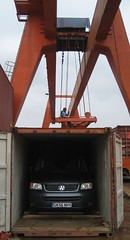Farewell India; good riddance Indian roads
Madras Hotel Room: hot sticky and without our van. The van is now in a box and after 240 days of driving, tomorrow we resort to an aeroplane to Dubai. We have done our final miles of driving in India, which took us to a large container depot north of Chennai. It poured with rain all the way, so Italian customs are bound to be delighted with the amount of pure Indian grot we have collected all over the bodywork. After much head scratching, head wobbling, waiting, clearing of customs formalities and standing around in muddy puddles, we drove the van into its container before the locals nailed it down with bits of wood and tied it in with some yellow string. Shortly afterwards, a large orange crane took the container away, whisking it over our heads as we waved goodbye to the van of dreams. Now all we can do to track the progress of our van is to wait for sporadic emails from our portly shipping agent, Satish, or to try and follow the shipment online (though the tracking website at the moment rather worryingly tells us that our container is still empty).
Since we dropped off the van, we have slept, explored the dubious “sights” of Chennai and slowly recovered our nerves after weeks of driving on Indian roads. Speaking of which, we have put together a little quiz for anyone who is interested in driving in India:
1) What should you do before changing lanes?
a. Blow your horn. Loudly and repeatedly.
b. Just swing into the lane and keep driving (do not look up under any circumstances, that would be a sign of weakness).
c. Speed up and drive parallel to an annoying little yellow auto rickshaw until you force it out of the way and thus get a lane automatically.
d. Turn the steering wheel sharply until you hear your car scraping against another.
e. Erm, what are lanes anyway?
2) What should you do before overtaking?
a. Blow your horn. Loudly and repeatedly.
b. Use your indicators to clearly demonstrate the manoeuvre you are about to make. Oh, no, don’t be stupid. You are in India: no-one does this. Ever.
c. Overtake in any way you can, no matter who or what is in the way. Getting ahead in life starts here.
d. Look in your wing mirrors. Oh no, you can’t do that, you have folded them in like any good Indian driver would (wouldn’t want to create the misleading impression that you might use them, after all).
e. If the car that you are overtaking contains white people (gora), ensure that all members of your vehicle gawk out of the window, including you the driver (why waste time looking at the road?).
3) Who has the right of way on the road?
a. Whoever blows their horn loudest and most repeatedly.
b. Whoever flashes their headlights first to say that they are coming through. (This actually is the rule: and you thought that fastest finger first was only for quiz shows).
c. Wandering cows. The holy cows are the only thing that trumps fastest finger first. And don’t they know it.
d. The bouncing kamikaze buses.
e. The car with the most dents.
4) When driving on the highway nice and politely, on the correct side of the road and at the correct speed, what might you encounter?
a. At night: totally unlit, slow moving tractors coming the wrong way towards you on your carriageway.
b. At night: totally unlit, slow moving lorries coming the wrong way towards you on your carriageway.
c. At night: totally unlit, fast moving auto rickshaws coming the wrong way towards you on your carriageway.
d. Totally unmarked, aggressive speed humps in the middle of the only decent stretch of flat carriageway for miles.
e. Road works (times one million) always complete with as many free-for-all, death defying contra flows as possible (no signs or barriers in sight).
f. Road kill (lots and lots of varieties – dead donkey or dog with rigor mortis, anyone?)
5) What are Indian traffic police for?
a. Modelling the latest line in sand coloured safari suits.
b. Demonstrating how to be one of the least efficient human beings on earth.
c. Sleeping under trees.
d. Putting up big barriers in the motorways to create chicanes and cause endless traffic jams and / or accidents.
e. A target for Round-the-Worlders to verbally (or physically if things get really bad) abuse.
f. Managing traffic…. no, that one was a joke.



